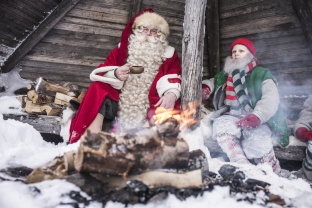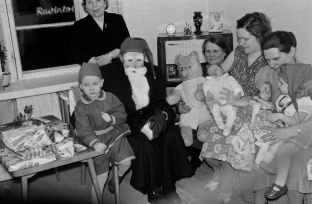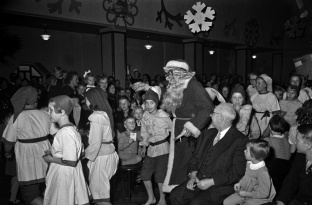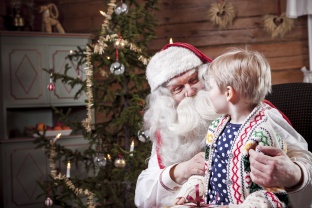Santa Claus tradition in Finland
| Santa Claus tradition in Finland | ||||
|---|---|---|---|---|
| In the national inventory | ||||
|
Practitioners and people who know the tradition well

The Finnish Santa Claus tradition is known everywhere in Finland and globally among Finnish communities. The Finnish Santa Claus tradition is practised by nearly all Finnish families, primarily families with children. On Christmas Eve, Santa Claus in the flesh visits the homes of most families with children, bringing joy to their Christmas, asking the children about their year and any good deeds they had done, bringing gifts and creating the special Christmas spirit through his own physical presence. This is the climax of the Finnish Santa Claus tradition.
The Santa Claus tradition is mainly maintained by parents, who tell their young children about Santa Claus, but the media also talks about Christmas traditions and Santa Claus. The public service media company, Yleisradio i.e. the Finnish Broadcasting Company, has dedicated its morning on Christmas Eve to a programme where people can contact Santa Claus. Children can call the ‘Santa Claus’ hotline’ by phone on the morning of Christmas Eve and talk to Santa Claus in person. People can also send in Christmas greetings to the programme by email and online, and these messages are read out in the programme.
For twenty years now, the Yleisradio news has made a short TV clip for international distribution, showing Santa Claus’ departure from Lapland. Before Christmas 2016, it was sent to 80 different countries and through the international broadcasting companies it spread all over the world to the countries celebrating Christmas as well as to current affairs programmes of China’s national TV broadcasting company CCTV and to some Islamic countries, such as Malaysia and Indonesia. The Christmas season’s opening ceremony events are held at many Finnish cities, and Santa Claus plays a central role in them. The Christmas season’s opening ceremony held at the Arctic Circle in Rovaniemi, Finnish Lapland, has been organised through cooperation between local operators for decades, at the turn of November and December.
Practising of the tradition
The Finnish way of celebrating Christmas usually means that families spend Christmas together, spending time with each other and eating a traditional Christmas meal. In families with children, in particular, Santa Claus also visits the families at the family’s home. Traditionally, Santa Claus first asks if the children have been good. After this, the youngest children may sometimes sing him a Christmas carol, nervous and blushing up to their ears. After this, Santa Claus usually starts to share out the Christmas presents and the children usually help him with this task. In Finland, most children truly believe in Santa Claus even up to school age. An essential part of the Finnish tradition is that Santa Claus lives on Korvatunturi fell in Lapland, where there is snow and reindeer that pull Santa’s sleigh. From the beginning of the tradition, Santa Claus has worn a long coat with a sheep’s-wool lining, and over time the coat’s colour became red. Another essential feature of the tradition are the elves that build presents in their workshop all year round. The elves traditionally wear a grey broadcloth costumes and all of them, Santa included, wear a red Christmas hat.
Waiting for Santa on Christmas Eve is an essential part of the Finnish Santa Claus tradition. Because of the youngest children, Santa Claus usually visits the family in late afternoon so that the rest of Christmas Eve and the family’s own traditions can go on without a hitch.
Children still write letters to Santa before Christmas, mostly with Christmas wish lists. In some letters, the children also tell Santa how good they have been and what good deeds they have done. Since 1985, the Santa Claus' Main Post Office in Rovaniemi at the Arctic Circle has received about 18 million letters to Santa. In recent years, Santa Claus has received over 500,000 letters a year from about 200 different countries. In 2016, Santa Claus received the most letters from China, Italy and Poland.

The background and history of the tradition
The Finnish Santa Claus is made of many different ingredients. He is a cross between the European gift-giving creatures and the ugly goat-like creatures that visited homes on St. Knut's Day in Finland. The most important role model for the Finnish Santa Claus, however, was Saint Nicholas, who, according to the most well-known story, was a bishop who lived in the 4th century in Myra, in Asia Minor. Nicholas was a pious man, a philanthropist and a protector of children, especially orphans. He helped his subjects in many different ways. For example, Nicholas gave gold coins to a poor man so that he would have a dowry for his daughter and she could marry. As a bishop, Nicholas became an invisible, secret benefactor. The saint’s reputation spread to many countries and people started giving gifts on his anniversary, on 6th December. The Dutch, for example, still receive their gifts on this day. The America Santa Claus is an adaptation of Saint Nicholas.
Dutch migrants brought their gift-giving tradition to America, where people started to connect Saint Nicholas to the Christian Christmas instead of the 6th of December. Saint Nicholas transformed into Santa Claus and became a fat, jolly, old and fatherly figure. The American Santa Claus lives at the North Pole and arrives the night before Christmas, riding a sleigh pulled by reindeer and dropping gifts down the chimneys. The ancestors of the Finnish Santa Claus were nuuttipukkis, St Knut Day’s goat-like creatures that visited homes, but not to give gifts – instead, they asked for food and drink, especially liquor or beer. The St Knut Day’s tradition is still alive in few areas in Satakunta.
The Finnish Santa Claus has also been greatly influenced by his American colleague. However, the Finnish Santa Claus visits children in person and gives them presents, whereas the American Santa Claus can only be seen in department stores. These personal visits to children’s homes are the most Finnish aspect of our Santa Claus, and it comes from the St Knut Day’s nuuttipukkis. Santa Claus has visited homes since the 1920s, and gradually the tradition became more common through all social classes. In the beginning, Santa Clauses usually visited bourgeois homes. During the wars, Santa Clauses also entertained the troops on the front lines.

The transmission of the tradition
In families, the Santa Claus tradition passes on from one generation to the next, developing and maybe adopting new features. Old photos in family albums or picture folders on computers as well as the memories of the eldest in the family should be kept in mind when planning future Christmas celebrations. The tradition passes through families and the procession of Christmas Eve has been learned at childhood homes, and people aim to follow at least some experiences remembered and cherished by the eldest family members.
The Santa Claus Foundation upholds the Santa Claus tradition and aims, for its part, to maintain the Finnish Santa Claus tradition and also share information about Santa Claus’ methods with everyone who brings up Santa Claus, also internationally. According to its rules, ‘the aim of the Santa Claus Foundation is to improve the well-being of the children of the world and to maintain the global image of Finland as the true Christmas country and as the homeland of Santa Claus. ’ The Santa Claus Foundation strengthens the Finnish Santa Claus culture and tradition. The Foundation aims to be a promoter and spokesperson for the Finnish Santa Claus culture. The Finnish Santa Claus tradition is also exported abroad in order to share Finnish customs. The utilisation of the tradition has mainly included tourism promotion and some export promotion events. The purpose of the Santa Claus Foundation is to collect the Finnish Santa Claus stories into a more extensive, cohesive history.
Elävä Arkisto, living archive, maintained by the Finnish Broadcasting Company, is a service open to all, where people can view film and video material about Santa Claus from past decades. The Finnish Literature Society (SKS) has collected Finnish Santa Claus experiences, which have been quoted in some books about Christmas, but the archive materials are not as easily accessible as those of the Finnish Broadcasting Company. Finnish libraries have also often offered special promotion shelves for Christmas books in November and December. Today, Santa Claus also has a strong presence on social media: on Facebook, WhatsApp and, for example, the Chinese Weibo and WeChat.

Santa Claus’ Office in Rovaniemi is located in Santa Claus Village. The first plans for Joulumaa, Christmas land, were drawn up as early on as in the 1970s, but the Santa Claus Village’s current form and extent was only achieved in the beginning of 2000s. However, Santa Claus’ Office has been in operation since 1985. Stories about the Finnish Santa Claus are also told to foreign reporters who visit Finland, invited by the Ministry for Foreign Affairs of Finland and Visit Finland. In 2016, nearly 1,000 international media guests visited Rovaniemi to report about Santa Claus. In Santa Claus’ Office in Rovaniemi, guests can meet the Finnish Santa Claus, free of charge. During the course of a year, Santa Claus’ Office has over half a million visitors, nearly 100,000 in December alone from about 130 different countries. Today, Santa Claus also has a strong presence on social media: on Facebook, WhatsApp and, for example, the Chinese Weibo and WeChat.
The future of the tradition
This tradition will remain a part of the Christmas celebrations of Finnish families, at least for the families that spend Christmas in Finland. Due to the stricter holiday rules of schools, families take more holidays abroad during the Christmas holiday. In such cases, they will leave out Santa Claus’ visit and only keep the tradition of giving gifts. This may affect the Christmas celebration traditions of future adults. Christmas in itself is such a strong part of Finnish culture that the tradition is not in danger of vanishing from people’s minds, but it may change its form. The thoughts mentioned in the section Safeguarding the tradition may have a positive effect on the Finnish Santa Claus tradition. Similarly, carrying out a potential review of the necessity of a Finnish Santa Claus strategy and its potential implementation will strengthen the preservation and development of the Santa Claus tradition.
With regard to the future of the tradition, the story of Santa Claus is important; what should it be and for what purpose could it be needed? Promotion of commercial purposes cannot be the only reason for preserving and developing the Santa Claus tradition. The Santa Claus Foundation is currently reviewing whether Finland should have a national Santa Claus strategy. The purpose is to facilitate Santa Claus’ duty of promoting good deeds and being good as well as being rewarded for such acts, thus preventing the use of Santa Claus for promotion of purely commercial interests. The Santa Claus Foundation can also now more actively suggest Christmas-themed materials to the media well in advance of the Finnish Christmas season. All year round, the public can visit Santa Claus in Santa Claus’ Office in Rovaniemi. The Finnish Santa Claus also welcomed foreign cruise passengers in Helsinki West Terminal for the first time during the summer season of 2017.
The communities behind this submission.
Santa Claus Foundation, Business Finland / Visit Finland
Bibliography and links to external sources of information
YLE Elävä arkisto: Joulupukki muitten silmin (1966)
Visit Rovaniemi:Joulupukki ja joulun taika
M&M 14.3.2017: Uusi tutkimus selvitti Suomen kiinnostavimmat brändit
M&M 22.9.206: Joulupukki sai oman tilin Kiinan Weibo-palveluun
M&M 16.12.2015: Joulupukki kiinnostaa - Rovaniemi vetää kansainvälisiä mediaryhmiä
Lapin Kansa 16.10.2015: Turistimagneetti, joka tuottaa häpeää
YLE Uutiset 23.12.2010: Joulupukki lähtee matkaan
Aalto Satu ( toim. )1999: Suuri perinnekirja. Suomalaista juhlaperinnettä ennen ja nyt. Karisto. Nirkko Juha - Vento Urpo ( toim. ) 1998 (1994): Joulu joutui - Juhlatietoa, kuvia ja kertomuksia. SKS.
